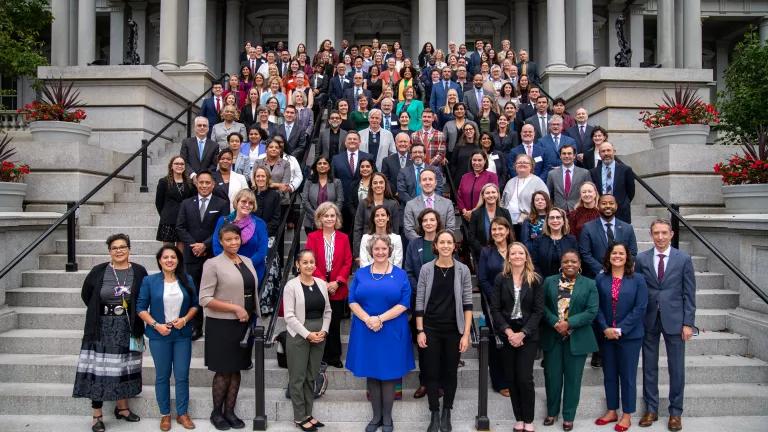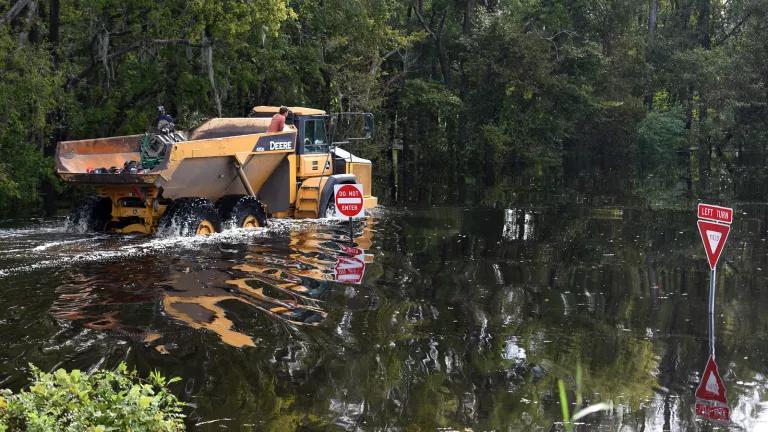President Biden Charts New Course Toward Climate Resilience
The Biden administration’s new National Climate Resilience Framework will help the federal government align decision-making and investments with the need to adapt to climate change.

The White House brought together leaders from government agencies, nonprofit organizations, businesses, and philanthropic foundations to discuss how the nation can accelerate climate resilience efforts.
The White House Climate Resilience Summit, September 2023
At the end of September, the Biden administration released the National Climate Resilience Framework at a White House Climate Resilience Summit. The framework establishes a set of principles and objectives to help the federal government align decision-making and financial investments with the pressing need to anticipate and adapt to the impacts of climate change. The release of the National Climate Resilience Framework may signal that climate adaptation and resilience will be a higher priority for the remainder of President Biden’s time in the White House.
Since taking office, his administration has taken a whole-of-government approach to addressing the climate crisis. While initially focused on addressing the root causes of climate change, the Biden administration managed to accomplish more than previous administrations to advance climate resilience and adaptation efforts. Still, many observed that climate resilience and adaptation were playing a distant second fiddle to mitigation in the administration’s climate agenda—and in the staffing of the White House Climate Policy Office.
The release of the National Climate Resilience Framework indicates that the president intends to bring a new focus and the same whole-of-government approach to resilience as it had previously brought to climate mitigation.
The framework was released on September 28 at a White House Climate Resilience Summit, which I attended along with about 50 representatives of federal agencies, nonprofit organizations, business leaders, and philanthropic foundations. Bringing this select group together signals that the administration is intent on bringing more focus to climate resilience and adaptation efforts.
What’s in the president’s National Climate Resilience Framework?
The National Climate Resilience Framework lays out six broad objectives for the federal government:
- Embed climate resilience into planning and management.
- Increase resilience of the built environment to both acute climate shocks and chronic stressors.
- Mobilize capital, investment, and innovation to advance climate resilience at scale.
- Equip communities with the information and resources needed to assess their climate risks and develop the climate resilience solutions most appropriate for them.
- Sustainably manage lands and waters to enhance resilience while providing numerous other benefits.
- Help communities become not only more resilient but also more safe, healthy, equitable, and economically strong.
Addressing the growing impacts of climate change requires a paradigm shift in how the nation makes decisions and sets priorities. Almost all government policies and decisions are informed by the climate of the past and not the climate of the future—where decisions will ultimately play out.
For example, on the Colorado River, water was over-allocated to states because of a poor understanding of how much water was truly in the river system. Now, in the midst of a 23-year drought that’s more intense than any of the past millennium, we are acutely aware of how much less water there actually is. The folly of states being allocated water that doesn’t exist is obvious, and changes are in the works.
Similarly, homes, businesses, and infrastructure are required to be elevated above the height of the so-called 100-year flood, as indicated on flood maps produced by the Federal Emergency Management Agency (FEMA), but these maps are based exclusively on historical data and are often years (or even decades) out of date. As a result, these maps ensure that development is sited and designed based on what the flood risk used to be—not on what it will be. A legal petition filed by NRDC and the Association of State Floodplain Managers has initiated a long-overdue process for correcting such problems.
The White House’s National Climate Resilience Framework states that: “Effectively integrating climate change into planning, design, and management means reducing reliance on past events as analogues for the future.” This is an important recognition of the need to incorporate future conditions into government policies and decisions, such as regulations, codes and standards, permit requirements, grant making criteria, etc.
The framework also recognizes that the impacts of climate change are disproportionately harming low-income communities and communities of color—impacts that need to be addressed today, regardless of our emissions trajectory. These same communities often lack the necessary capacity to implement equitable, forward-looking adaptation solutions.
Addressing these issues is at the heart of President Biden’s Justice40 Initiative. It isn’t sufficient to simply make funding available; it must reach the communities who are most in need. And all too often, those communities do not have the staff capacity or expertise to apply for federal grant funding, much less the ability to plan or manage a complex project if funding is approved.
That’s why agencies are also investing more in community capacity building through programs like FEMA’s Building Resilient Infrastructure and Communities (BRIC) program, the Department of Energy’s Energy Efficiency and Conservation Block Grant Program, and the U.S. Environmental Protection Agency’s Environmental and Climate Justice grants. Elements of the framework are already in the early stages of implementation.
What’s not in it?
Perhaps the biggest omission in the framework is designating who’s responsible for these activities across all federal agencies and offices.
Climate resilience should be the responsibility of every agency, which President Biden recognized when he directed major agencies to develop resilience plans. However, every agency also has the potential to undermine the objectives of the National Climate Resilience Framework if they fail to account for future climate impacts or their actions lead to inequitable outcomes.
One safeguard would be to designate a chief resilience officer, who can ensure that climate-informed standards and decision-making criteria are applied and help coordinate interagency activities. Many states and communities now have a chief resilience officer—a position that does not exist in the federal government.
But it could happen under a bipartisan legislation introduced by Senators Chris Coons (D-DE) and Lisa Murkowski (R-AK). If enacted, both a federal chief resilience officer and an office of climate resilience would be established. They would oversee and coordinate the efforts of all federal agencies and offices, as well as create a national climate resilience strategy.
The other area where the framework can be improved is establishing timelines, milestones, and metrics for success. While the framework defines the federal philosophy for addressing climate resilience, it does not define when it will be implemented, how it will be implemented, or how we will know if it is succeeding.
With the growing frequency and severity of climate-fueled disasters, we need a much better coordinated federal effort around climate resilience and adaptation efforts. The president’s National Climate Resilience Framework establishes high-level objectives and guidelines for agencies. The next step may be to establish the authority and responsibility to turn the framework into action (perhaps through the creation of a chief resilience officer) with actual timelines, milestones, and metrics for action.
With the addition of these missing ingredients, the National Climate Resilience Framework could be the foundation for a much more ambitious national climate resilience strategy.




